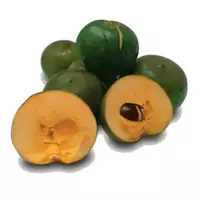Lukuma

The lucuma plant or Pouteria lucuma belongs to the Sapotov family and belongs to the genus Puteria. In its biological structure, the lucuma plant is an evergreen fruit tree that is common in Southeast Asian countries, as well as Peru, Ecuador and Chile. In addition, the lucuma tree is cultivated on an industrial scale in the Hawaiian Islands, Mexico, Costa Rica, as well as in the historical homeland of the fruit plant in Bolivia.
It is noteworthy that the lucuma tree grows at an altitude of up to 3000 meters above sea level. In itself, the lucuma plant reaches, as a rule, 15 meters in height. The exotic lucuma plant, like other representatives of the Sapotov family, is distinguished by leathery elliptical-sized leaves, which on average reach 25 cm in length.
The fruits of the lucuma have an elongated shape and are covered in a fully ripened state with a delicate rather thin peel, which differs in the so-called bright yellow "blush. " Inside the fruits of the onion is sweet flesh, which is distinguished by a bright yellow color and a mealy consistency. As a rule, up to 5 glossy seeds can be found in the sweet flesh of lucuma fruits. It's worth noting that the lucuma pulp tastes like maple syrup.
It is also noteworthy that lucuma fruits are used as a natural sugar substitute. On average, one fruit tree of lucuma can bring up to 500 kg of fruit per year. In history, there are cases when in lean times or during the invasion of pests, entire peoples of South America escaped from starvation thanks to the fruits of lucuma.
Currently, among the population of the American continent, the lucuma plant is called nothing more than a "tree of life. " In written sources of the indigenous people of South America, the fruits of the lucum were poetically called the "lost harvest of the Incas. " Lucuma fruits are eaten fresh. In addition, the fruits of the plant are preserved, and also stewed in their own juice.
The fruits of the tropical locum plant are used to produce a refreshing vitamin juice. Often, lucuma fruits are dried and then ground to a powdery state. In this form, lucuma becomes an ingredient in confectionery, sweet desserts and ice cream. Lucuma pulp is characterized by a high content of bet-carotene in its composition.
This biologically active compound of natural origin helps the human body to synthesize vitamin A. Frozen lucuma pulp can be purchased in specialized stores, including via the Internet. The composition of lukuma contains sucrose, glucose, as well as fructose. Recently, baby food producers have begun to give their preference to the fruits of onion, as a natural substitute for sugar.
lukumas 329 kCal
Energy value of lucuma (Ratio of proteins, fats, carbohydrates - ju):
Proteins: 0 g (~ 0 kCal)
Fats: 0 g (~ 0 kCal)
Carbohydrates: 0.1 g (~ 0 kCal)
Energy ratio (b | y): 0% | 0% | 0%
 Español
Español Français
Français Português
Português Русский
Русский 简体中文
简体中文 繁體中文
繁體中文 日本語
日本語 한국어
한국어 العربية
العربية Türkçe
Türkçe Қазақ
Қазақ Deutsch
Deutsch Italiano
Italiano Українська
Українська
